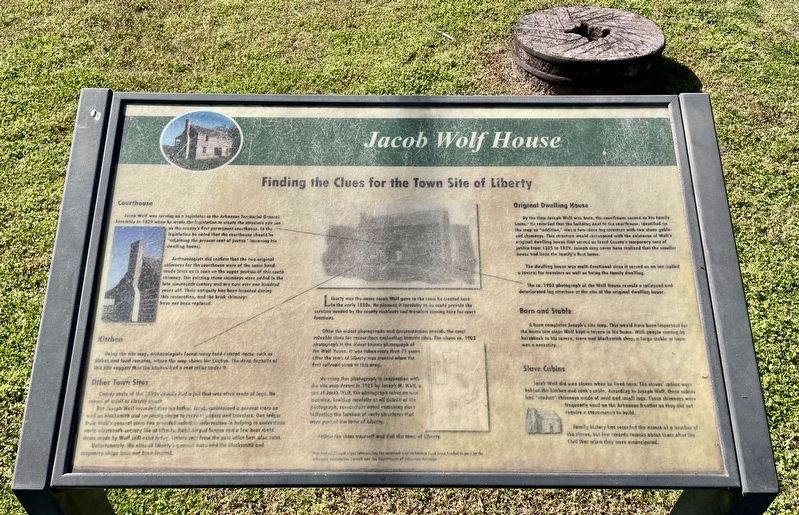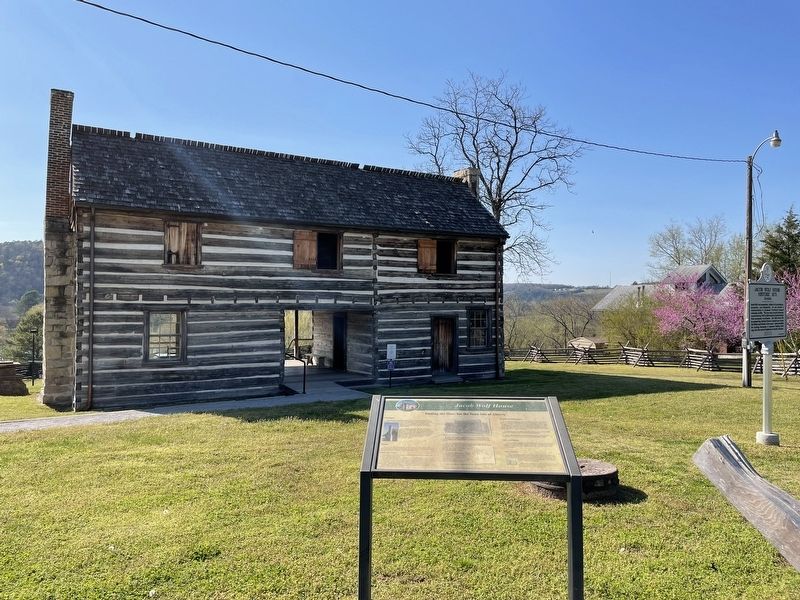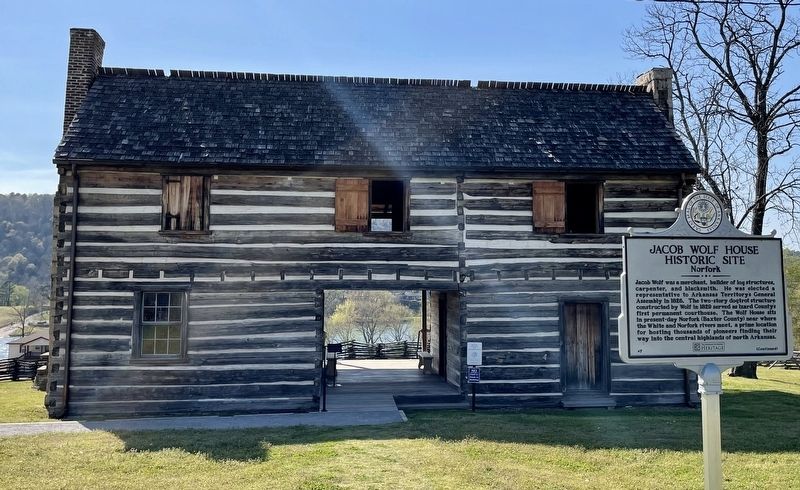Jacob Wolf House
Finding the Clues for the Town Site of Liberty
Courthouse
Jacob Welt was serving as a legislator in the Arkansas Territorial General Assembly in 1829 when he wrote the legislation to create the structure you see as the country's first permanent courthouse. In the legislation he noted that the courthouse should be "adjoining the present seat of justice” (meaning his dwelling house).
Archaeologists did confirm that the two original chimneys for the courthouse were of the same handmade brick as is seen on the upper portion of this south chimney. The existing stone chimneys were added in the late nineteenth century and are now over one hundred years old. Their antiquity has been honored during this restoration, and the brick chimneys have not been replaced.
Kitchen
Using the site map, archaeologists found many food-related items, such as
dishes and food remains, where the map shows the kitchen. The deep deposits at this site suggest that the kitchen had a root cellar under it.
Other Town Sites
County seats of the 1830s usually had a jail that was often made of logs. No
record of a jail at Liberty exists.
But Joseph Wolf recorded that his father, Jacob, maintained a general store as
well as blacksmith and carpentry shops to serve residents and travelers. One ledger from Wolf's general store has provided valuable
Unfortunately, the sites of Liberty's general store and the blacksmith and carpentry shops have not been located.
Liberty was the name Jacob Wolf gave to the town he created here in the early 1820s. He planned it carefully so he could provide the services needed by the county residents and travelers coming here for court functions.
Often the oldest photographs and documentation provide the most valuable clues for researchers evaluating historic sites. The above ca. 1903 photographs is the oldest known photograph of the Wolf House. It was taken more than 75 years after the town of Liberty was created when the first railroad come to this area.
By using this photograph in conjunction with the site map drawn in 1915 by Joseph M. Wolf, a son of Jacob Wolf, the photograph takes on new meaning. Looking carefully at all details of the photograph, researchers noted vanishing clues indicating the location of early structures that are part of the town of Liberty.
Follow the clues yourself and find the town of Liberty.
Original Dwelling House
By the time Joseph Wolf was born, the courthouse served as his family
home. Its recorded that
The dwelling house was multi-functional since it served as an inn (called a tavern) for travelers as well as being the family dwelling.
The ca. 1903 photograph of the Wolf House reveals a collapsed and deteriorated log structure at the site of the original dwelling house.
Born and Stable
A barn completes Joseph's site map. This would have been important for
the home site since Wolf kept a tavern in his home. With people coming by
horseback to his tavern, store and blacksmith shop, a large stable or barn
was a necessity.
Slave Cabins
Jacob Wold did own slaves when he lived here. The slaves' cabins were
behind the kitchen and cook's cabin. According to Joseph Wolf, these cabins had
"mudcat" chimneys made of mud and small logs. These chimneys were
frequently used on the Arkansas frontier as they did not require a stonemason to build.
Family history has recorded the names of a number of the slaves, but few records remain about them after
the Civil War when they were emancipated.Erected by Arkansas Humanities Council; Department of Arkansas Heritage.
Topics. This historical marker is listed in this topic list: Settlements & Settlers. A significant historical year for this entry is 1829.
Location. 36° 12.624′ N, 92° 17.208′ W. Marker is in Norfork, Arkansas, in Baxter County. Marker can be reached from the intersection of Arkansas Route 5 and Wolf Street. Touch for map. Marker is at or near this postal address: 13775 Highway 5, Norfork AR 72658, United States of America. Touch for directions.
Other nearby markers. At least 8 other markers are within 11 miles of this marker, measured as the crow flies. Jacob Wolf House Historic Site (here, next to this marker); a different marker also named Jacob Wolf House (a few steps from this marker); a different marker also named Jacob Wolf House (within shouting distance of this marker); Old Military Road (approx. 5.9 miles away); Mountain Home Cemetery (approx. 9.9 miles away); Skirmishes Near Mountain Home (approx. 10.2 miles away); Mountain Home Commercial Historic District (approx. 10.2 miles away); City Hall (approx. 10.3 miles away). Touch for a list and map of all markers in Norfork.
Regarding Jacob Wolf House. The house was listed on the National Register of Historic Places in 1973.
Additional commentary.
Please report objectionable advertising to the Editor.
Cat-and-clay construction, also known as “mudcat” and “stick and mud” construction appears to have been brought to America by early Scottish and Irish immigrants. The “cat” part of the term is from the old Scottish language and refers to oblong rolls of pliable clay mixed with weeds, grass, horsehair; anything at hand that can help to reinforce the clay and hold it together instead of bricks or stones. [Source: Arkansas Historic Preservation Program, Historic Site Manager]
Credits. This page was last revised on April 22, 2021. It was originally submitted on April 21, 2021, by Mark Hilton of Montgomery, Alabama. This page has been viewed 202 times since then and 27 times this year. Photos: 1, 2, 3. submitted on April 21, 2021, by Mark Hilton of Montgomery, Alabama.


